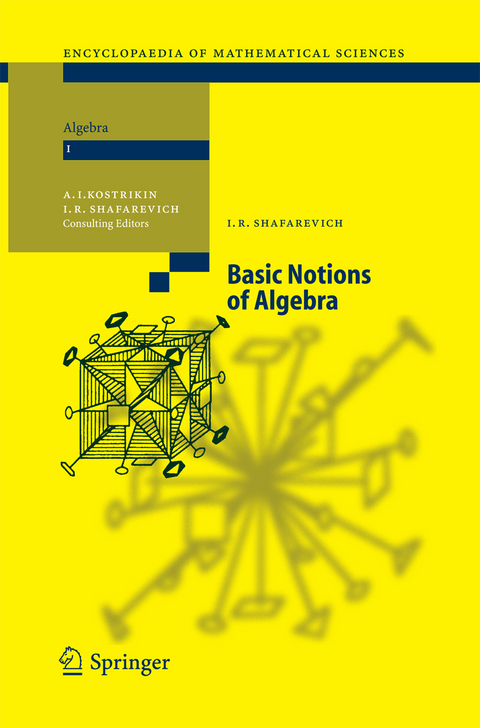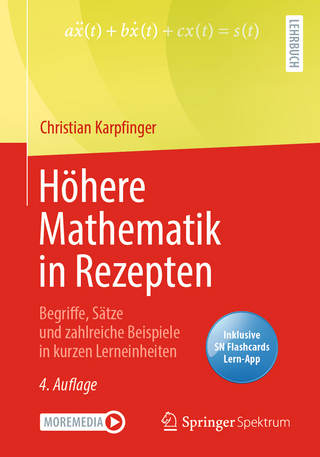
Basic Notions of Algebra
Springer Berlin (Verlag)
978-3-642-42516-5 (ISBN)
22. K-theory 230 A. Topological X-theory 230 Vector bundles and the functor Vec(X). Periodicity and the functors KJX). K(X) and t the infinite-dimensional linear group. The symbol of an elliptic differential operator. The index theorem. B. Algebraic K-theory 234 The group of classes of projective modules. K , K and K of a ring. K of a field and o l n 2 its relations with the Brauer group. K-theory and arithmetic. Comments on the Literature 239 References 244 Index of Names 249 Subject Index 251 Preface This book aims to present a general survey of algebra, of its basic notions and main branches. Now what language should we choose for this? In reply to the question 'What does mathematics study?', it is hardly acceptable to answer 'structures' or 'sets with specified relations'; for among the myriad conceivable structures or sets with specified relations, only a very small discrete subset is of real interest to mathematicians, and the whole point of the question is to understand the special value of this infinitesimal fraction dotted among the amorphous masses. In the same way, the meaning of a mathematical notion is by no means confined to its formal definition; in fact, it may be rather better expressed by a (generally fairly small) sample of the basic examples, which serve the mathematician as the motivation and the substantive definition, and at the same time as the real meaning of the notion.
What is Algebra?.- Fields.- Commutative Rings.- Homomorphisms and Ideals.- Modules.- Algebraic Aspects of Dimension.- The Algebraic View of Infinitesimal Notions.- Noncommutative Rings.- Modules over Noncommutative Rings.- Semisimple Modules and Rings.- Division Algebras of Finite Rank.- The Notion of a Group.- Examples of Groups: Finite Groups.- Examples of Groups: Infinite Discrete Groups.- Examples of Groups: Lie Groups and Algebraic Groups.- General Results of Group Theory.- Group Representations.- Some Applications of Groups.- Lie Algebras and Nonassociative Algebra.- Categories.- Homological Algebra.- K-theory.
From the reviews:
"This is one of the few mathematical books, the reviewer has read from cover to cover ... The main merit is that nearly on every page you will find some unexpected insights..." (Zentralblatt für Mathematik und Ihre Grenzgebiete, 1991)
"...which I read like a novel and undoubtedly will become a classic. ... A merit of the book under review is that it contains several important articles from journals which are not all so easily accessible. ... Furthermore, at the end of the book, there are some Notes by the author which are indispensible for the necessary historical background information. ... This valuable book should be on the shelf of every algebraist and algebraic geometer." (Nieuw Archief voor Wiskunde, 1992)
"... There are few proofs in full, but there is an exhilarating combination of sureness of foot and lightness of touch in the exposition ... which transports the reader effortlessly across the whole spectrum of algebra.... The challenge to Ezekiel, "Can these bones live?" is, all too often, the reaction of students when introduced to the bare bones of the concepts and constructs of modern algebra. Shafarevich's book - which reads as comfortably as an extended essay - breathes life into the skeleton and will be of interest to many classes of readers..." (The Mathematical Gazette, 1991)
"... According to the preface, the book is addressed to "students of mathematics in the first years of an undergraduate course, or theoretical physicists or mathematicians from outside algebra wanting to get an impression of the spirit of algebra and its place in mathematics." I think that this promise is fully justified. The beginner, the experts and also the interested scientist who had contact with algebraic notions - all will read this exceptional book with great pleasure and benefit." (Zeitschrift für Kristallographie, 1991)
"This is a truly wonderful book, one that anyone teaching algebra should read and which should be pointed out to talented students, particularly those who want to know a little more about what and why abstract algebra is. This book is volume 1 in the Algebra section of the Springer Encyclopedia of Mathematical Sciences ... . The examples are particularly well chosen, simple enough to understand... . one that will enrich your understanding of algebra and deepen your knowledge of mathematics as a whole." (Fernando Q. Gouvêa, MathDL, March, 2007)
| Erscheint lt. Verlag | 20.11.2014 |
|---|---|
| Reihe/Serie | Encyclopaedia of Mathematical Sciences |
| Übersetzer | M. Reid |
| Zusatzinfo | IV, 260 p. |
| Verlagsort | Berlin |
| Sprache | englisch |
| Maße | 155 x 235 mm |
| Gewicht | 409 g |
| Themenwelt | Mathematik / Informatik ► Mathematik ► Algebra |
| Mathematik / Informatik ► Mathematik ► Geometrie / Topologie | |
| Schlagworte | Algebra • Associative algebra • category • category theory • cohomology • Commutative Ring • Group representation • groups • group theory • Homological algebra • Homology • Homomorphism • K-theory • modules |
| ISBN-10 | 3-642-42516-X / 364242516X |
| ISBN-13 | 978-3-642-42516-5 / 9783642425165 |
| Zustand | Neuware |
| Informationen gemäß Produktsicherheitsverordnung (GPSR) | |
| Haben Sie eine Frage zum Produkt? |
aus dem Bereich


